The Geography of EmpireKeith Buchanan, Professor of Geography, Victoria University, Wellington, New Zealand.From three issues (June 1971–Jan 1972) of The Spokesman. [NB: This has nineteen maps]
CONTENTS:-
Part One: The Vietnamization of the World
Part Two: The Intellectual Pillage of the Third World
The Warning of John Donne
Updating the Slave Trade
The Stealing of Souls
The New Mercenaries
"Le virus de son autodestruction..."
Part Three: The Economic Pattern of Empire
Components in the "Underdeveloping Machine"...
Servicing the Machine ...
Uncle Sam's Wayward Nephews
The New Shape of Empire
Endnotes
"If most people are poor in the material things of life there is in much of this area [the Third World] a wealth of resources waiting to be tapped"
Eugene R. Black, Diplomacy and Economic Development
Part One: The Vietnamization of the WorldThe philosophy behind "Vietnamization" - the use of mercenaries and of the armies of client regimes in place of US combat troops - has guided the American national security bureaucracy for at least two decades. The increasing costs involved in assuming what Lyndon Johnson described as "the principal responsibility for the protection of freedom on earth" have, however, inspired a new rhetoric which emphasises the financial, as well as the political and psychological, advantages of employing "native" troops; an Asian soldier, it is emphasised, costs only one-fifteenth his American counterpart. Just as in the economic "development" of the Free World the advanced nations, and especially the US, supply the technology and the peoples of the Third World the man-power and the materials so, too, in the military field, the US will provide the tools and the training and the local boys will do the job (backed up, where they are still lacking in enthusiasm or dedication, by the helicopter gunships and B52s of the USAAF). "Each partner" observes Melvin Laird, "does its share and contributes what it best can to the common effort"; he adds "In the majority of cases, this means indigenous manpower organised into properly equipped and well-trained armed forces with the help of material, training, technology and specialised skills furnished by the United States". Perhaps the partial withdrawal from Vietnam is best carried through behind a rhetorical smokescreen which emphasises the novelty of Vietnamization but in truth the new model policy presented represents about as revolutionary a change as do the new season's autos as compared with those of 1970 or even 1960; the name may be new and exotic - but the motive force and the mechanism remain the same.The four cartograms [i.e. stylised map; areas proportional to population-RW] presented here draw on statistics from the D of D, AID and Congressional Record compiled and published by the North American Congress on Latin America1; they demonstrate some aspects of the global "mercenarization" (or Vietnamization") which has been a major component of US policy since at least 1950. The figures for military assistance expenditure certainly represent only a fraction of the total; for example, they do not include military aid to South Vietnam since 1966, nor the "inducements" to South Korea and Thailand to supply mercenaries for the Indochina War (at least $1 billion in each case). In addition, the cost of a wide range of "support" programmes is not included. The size of these can be gauged from the data furnished by AID to Richard Barnet which showed a total expenditure from 1953 to 1967 of over $46 billion for military aid or "supporting assistance"2; the D of D figures for "military assistance expenditures" (on which Map 1 is based) show a total of slightly over $33 billion over the period FY 1950-1968. The data used in constructing Map 1 and also Map 4 are thus minimum figures; it is, however, with the spatial pattern that we are concerned. The pertinent data for military assistance expenditures are summarised below: Military Assistance Expenditures Fiscal 1950-1968 | Area | | Total £ million | | East Asia | 9,747 | | | Near East and South Asia | 5,645 | 77 | | Europe | 14,201 | 95 | | Africa | 218 | 42 | | Latin America | 687 | 57 | | World | 33,260 | 84 |
Expenditure, as can be seen, was approximately evenly divided between Europe and the Near East-Asian regions, with nineteen-twentieths of the expenditure on Europe dating from before 1963; of this, almost one-third went to France to help in underwriting the costs of the First Indochina War. The "stabilization" of the African and Latin{47}American situations involved less expenditure and much of this was, by contrast, in the middle and late 'sixties. Geographically, the pattern is one of effort directed to consolidate three major regions: the NATO region of Europe, the CENTO region of the Middle East and the cluster of US client-regimes in Southeast and East Asia.
 | | Map 1 |
Outside these regions there is an interesting example of US aid to a communist state in the case of Yugoslavia and significant expenditures in some key countries such {48} as Ethiopia (expenditure doubled 1967-68), Brazil and Argentina. Map 2, showing the country-by-country distribution of foreign military personnel trained in the US, complements Map 1. 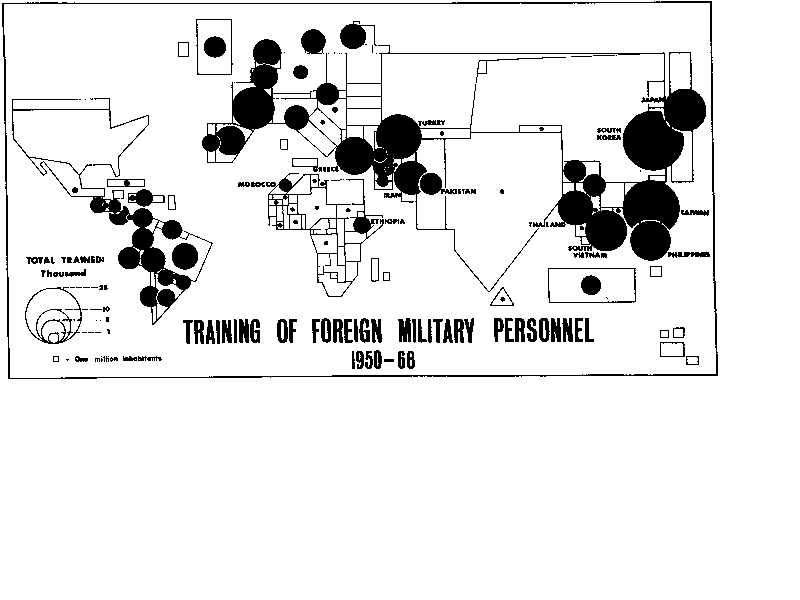 | | Map 2 |
The same three major areas of concern come out, but of the total of 287,221 personnel trained from FY 1950 to FY 1968 over one-half (153,817) were from the Near East-Asian regions. And the thrust of mercenarization in Latin America, towards the training of a US-oriented officer corps, is indicated clearly by the cartogram. In Africa, the pivotal countries are seen to be Morocco and Ethiopia. Seen as part of an unfolding global policy the training programmes show an acceleration in the latest period (FY 1964-FY 1968) in the African region (especially Morocco, Tunisia and the Congo) and in parts of Latin America (Argentina, Bolivia, Venezuela, Guatemala and El Salvador). And it is worth noting that in the military field ideological lines get a little blurred for, between FY 1950 and 1963, 844 officers from Yugoslavia were trained under the Military Assistance Programme. One of the more sophisticated types of technological expertise made available by the US is training in Chemical/Biological and Chemical/Biological/Radiological warfare.  | | Map 3 |
This training, according to Colonel Raymond T. Reid, Chief of Legislative Liaison, emphasises defensive tactics; however, the Colonel adds, "there can be no absolute guarantee that defensive tactics will not have some utility in framing offensive tactics". As late as 1961 CBR training was being made available to the Yugoslav army ("training is conducted", says Colonel Reid, "if a country desires the training"). The concentration in the NATO countries might be expected; more interesting is the number of officers from Middle Eastern/Near East countries and from the satellite countries of Southeast and East Asia who have benefitted from US expertise in this field. 95 Koreans, 72 Vietnamese and 29 Filipinos have been trained, many in courses dealing with the fundamentals of nuclear warfare and radiological defense and of biological warfare. These programmes - and the spatial pattern of countries taking advantage of them - give an extra dimension to US military plans for the Third World. Against what enemy, one must ask, are the armies of Argentina, Saudi Arabia or Greece developing their technological competence in the CBR field? Or those of the Philippines or Iran? Given what Barnet delicately terms "the decade of tacit understandings between cautious adversaries and judicious crisis management on both sides of the Elbe" the US has been increasingly able to turn much of its attention to what Arthur Schlesinger called the "gray areas", towards that universe of radical and increasing impoverishment known as the Third World. In this great belt of slums the most distinctive type of conflict is less that between states than that within states, resulting {49} from the increasing determination of the damned and disinherited to overturn the dominating clique of self.serving, externally-oriented, politicians and refashion society along new and more human lines. And so the Third World is "gray" in another sense, too, for the distinction between unrest, civil disobedience and civil war is nowhere clear cut and the distinction between police and military, both preoccupied with "containing" change, is at the best an arbitrary distinction. Against this background the sizeable amounts of US aid which have gone to building up the police forces in key sectors of the Third World can be readily understood, for such aid, which includes "radio equipment, antiriot gases, small arms and patrol vehicles", as well as training either in the US or locally, represents a logical extension of America's counter-insurgency drive. Between 1961 and 1969 almost a quarter of a billion dollars was devoted to police assistance and the training programme, modelled on the Military Assistance Programme, has, according to AID, reached "over one million policemen in the Third World"; assuming a Third World population of approximately 1,750 million this means one US-trained policeman (or counter-insurgent specialist) for each 1,750 people.3 The statistics on which Map 4 is based are undoubtedly an underestimate.  | | Map 4 |
Thus Thailand is credited with $71 million in police aid between 1961 and 1969; Wayne O'Neil, however, states that AID "spends about $35 million a year in Thailand, about 80 per cent going into counter-insurgency work, i.e. training police to deal with the population"4. The US, by its police training programmes, has built up a solid framework of repression in Latin America; has consolidated the hold of African governments in key sectors of that continent; and has provided client-regimes in the Middle East and East and Southeast Asia with the means of dealing with uncooperative elements among the local citizenry. The countries in each sector of the Tricontinental South receiving the most "aid" per capita in this field are listed below: US Police Assistance 1961-9 per head of 1970 Population ($) | Asia | Africa | America| Thailand | 2.01 | Liberia | 2.43 | Guyana | 1.27| Laos | 1.27 | Somalia | 1.60 | Panama | 1.07| Jordan | 1.12 | Ruanda | 0.32 | Dominican R. | 0.77| Cambodia | 0.39 | Congo Kinshasa | 0.28 | Costa Rica | 0.75| South Korea | 0.22 | Ethiopia | 0.12 | Salvador | 0.56 | | | | | |
This "aid" is very sensitive to internal conditions; thus "aid" to Colombia reached a peak ($1.8 million) in 1966, the year Camilo Torres was killed, while "aid" to the Philippines has climbed steadily as internal tensions have increased in recent years. By contrast, countries like Liberia or Venezuela, in which repression has become endemic, show a more steady year to year level of American help in keeping the disaffected "in their {50} place". And some countries, like Taiwan or Japan, have, it would seem, little need of outside expertise in this field.Half a century ago Joseph Schumpeter captured for us the terminal nightmare of another imperialism which sought to impose its vision of reality5 on the world it knew and which sought to be eternal - that of Imperial Rome. Wrote Schumpeter: "Here is the classic example of that kind of insincerity in both foreign and domestic affairs which permeates not only avowed motives but also probably the conscious motives of the actors themselves - that of a policy which pretends to aspire to peace but unerringly generates war, the policy of continual preparation for war, the policy of meddlesome interventionism. There was no corner of the known world where some interest was not alleged to be in danger or under actual attack. If the interests were not those of Rome, they were those of Rome's allies; and if Rome had no allies, then allies would be invented. When it was utterly impossible to contrive such an interest - why, then it was the national honour that had been insulted. The fight was always invested with an aura of legality. Rome was always being attacked by evil-minded neighbours, always fighting for a breathing space. The whole world was pervaded by a host of enemies and it was manifestly Rome's duty to guard against their indubitably aggressive designs. They were enemies who only waited to fall on the Roman people ..." (emphases added KB) A millennium and a half later Imperial America threshes about in the same disordered dream. And in the US attempts to Vietnamize the world we may see a striking parallel to the spectacle of Imperial Rome desperately buying mercenary allies to preserve its imagined "interests" while the fabric of Roman society disintegrated and a new society was taking shape in the shadowy lands beyond the limes...
Part Two: The Intellectual Pillage of the Third World
Professor Buchanan marshals a wealth of documentation to show how the material exploitation of the world by imperialism is conjoined with an insidious process of cultural subordination and spoliation. The Warning of John Donne
At first sight, the seventeenth century writer John Donne would seem irrelevant to the analysis of modern imperialism. But the John Donne of whom I think is not John Donne the poet, the rumour-ringed, enigmatic, sensuous adventurer, but John Donne the preacher, the passionate, compassionate and probing Dean of St. Paul's. And when I think of John Donne in the context of this paper I think of his sombre and fearsome warning: "Foole, this night they shall fetch away thy soule".6For, as I see it, these sombre words can be extended to the long night of colonialism and the tormented neocolonial night which has followed. The physical spoliation of those who lived, who still live, in the dark night of imperialism, the filching away of gold and copper and foodstuffs and fibres, is something all can see - but this material impoverishment may well prove to be of less significance than the undermining of indigenous cultures, the destruction of the personality, the stealing of the soul of those colonised. Moreover, as we shall see in this paper, this "stealing of souls", this cultural imperialism, is by no means a thing of the past, for, as the old forms of imperialism withered, new, more sophisticated and more subtle forms have taken their place ... The physical pillage of the world by the developed nations continues and to this has been added an even more destructive and pervasive intellectual pillage.7Eisenhower warned of the power of the "military-industrial complex" but this has not only grown more powerful since his warning but has co-opted new partners from the scientific and academic communities to become what some American scholars have termed "military-industrial-scientific-academic complex". Massive funding by the Pentagon and by the great foundations has made possible the integration into America's global strategies of a sizeable sector of the intellectual community; scholars are "bought, packaged and distributed to carry out state and corporation business at home and abroad" and the pursuit of Truth becomes the pursuit of "the truth of American capital and empire".8 Observes Claude Julien: "tightly bound to the economic empire, the military empire ... plays the determining role in the building up of the scientific empire which permits the United States to import highly qualified personnel, which in its turn contributes to reinforcing the power of the empire and establishing more firmly its influence in a world whose intellectual resources it exploits in the same fashion as it pillages its primary products ...
Science and culture are not only one of the glories of the empire but also among the principal sources of its wealth and power."9 And just as US business expands through the establishment of branch factories throughout the dependent territories of the empire10 so, too, does the scientific empire expand by putting out "business" to the universities of the empire. Thus, while the Massachusetts Institute of Technology got over $119 million in Defence Department funds in 1968, the Congressional Record11 shows that sizeable Defence Department funds dropped into the receptive laps of many overseas universities: to take but two examples, McGill University in Canada got over one and a quarter million dollars and the University of Sydney got almost three-quarters of a million dollars. In this paper attention is given to three aspects of American intellectual imperialism: the "pillage of brains" through the import into the USA of skilled personnel; the stealing of souls through {57} American infiltration of Third World educational Systems; and the mercenarization of the mind through Pentagon-sponsored research in the dependent "Coca-colonies" of the Empire (Map 1).  | Caption: The Cultural Empire.
American consumption patterns have been "sold" to a considerable section of humanity. The penetration of the world by a commodity like Coca-cola represents a good index of this Americanization. The map shows the general pattern of Coca-cola production as of 1969; note the recession of the Coca-cola empire in East China since 1949. |
Updating the Slave Trade
Discussing the economic relations between the developed and "underdeveloped" nations Pierre Jalée has pointed out that the drain of wealth from the Third World is one-and-a-half times as great as the total value of "aid"; he comments: "It is thus not the imperialist countries which aid the Third World but the Third World that aids imperialism".12This is equally true in the intellectual field and, while we are told much of the technical expertise which the developed nations are showering on nations whose underdevelopment makes them (as yet) of limited value as outlets for the White North's output of technological gimmickry, we are told rather less of the accelerating import of brains from the Third World into nations such as the USA. Yet this "brain trade", a more sophisticated twentieth century version of the slave trade, plays a fundamental role in perpetuating the under-development of the Third World and in making possible the accelerating technological and scientific progress of the developed nations, and especially of the USA. It is, in short, an agent of international polarisation, contributing, in Julien's words: "powerfully to the impoverishment of the poor countries in order better to enrich a wealthy nation which claims to wish to aid them."13 And, speaking of the USA, he emphasises the parallel with US material exploitation of the globe for: "the Empire draws off brains and specialists, in the same fashion as it draws off exorbitant profits from capital invested in the Third World"14 James A. Perkins, former President of Cornell University, estimated that, between 1949 and 1961, 43,000 scientists and engineers immigrated into the USA. Between 1962 and 1966 the total was approximately 60,000 - and of these 22,000 came from the Third World; in other words, the underdeveloped countries were furnishing over one-third of the highly-skilled personnel entering the USA. And while over the 1962-1966 period immigration from the developed countries into the USA increased 18 per cent, that from the Third World increased 71 per cent.15 The general pattern of this brain-drain is shown on the accompanying map (Map 2); this is based on a study carried out for the UN by Professor Ehsan Naraghi of the University of Teheran. 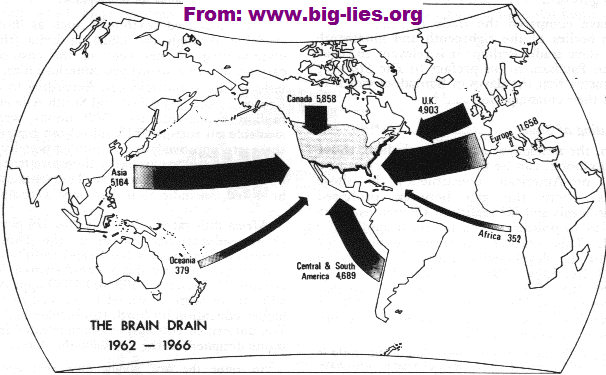 | Caption: The Brain Drain.
Skills, like capital are drawn by the magnet of high financial returns. Today the major magnet is the United States, whose drive towards world domination calls for an ever-expanding - and multi-national - army of scientists and technicians. Foreign and domestic counter-insurgency programmes, the space-race and the spy-in-the-sky programme - all these draw scientific personnel away from the basis human priority of creating a decent world for all men. One-third of the inflow of scientists over the period 1962-1966 came from the underdeveloped countries - and no amount of cash can compensate for this loss of human resources. |
16His definitions were different from the Lausanne study on which Julien relies and his data show a migration into the USA of some 10,000 "engineers and scientists" from the Third World over the same 1962-1966 period. Taking 1966 alone, Naraghi's data showed that 46 per cent of the scientists and specialists migrating into the USA came from the Third World. In the preceding year a survey showed that the number of doctors in the USA included 3,760 from the Philippines, 1,293 from India (where the ratio of doctors to population is 1:78,000) and 1,180 from Mexico (where the ratio is 1:21,000). That this drain on the scientific manpower of the emerging nations is not likely to diminish in the 1970s is suggested by the estimate that between 1965 and 1975 the US needs to import 38,000 scientific workers yearly, in other words, some 3 - 4 times as many as in the middle 'sixties. And that the various educational "aid" schemes work, not towards relieving the shortages of scientific and technical manpower in the Third World, but rather to increasing the size of the US's army of experts, is suggested by the fact that 80 per cent of the Asian students studying in the USA remain there after the completion of their studies.17 We do not have to postulate a deliberate conspiracy to explain these trends, for they are simply the result of a system "'whose structures are determined by the dominant economy".18 Under this system, skills, like capital, move not in the direction of the greatest social need but in the direction of greatest profits. And, as Claude Julien points out, since to the US power-elite American nationalism is the highest form of internationalism, it is easy to demonstrate that those who object to the pillage by the US of their physical and intellectual resources are simply victims of an out-moded, even chauvinistic, nationalism, unable to recognize this pillage as part of what Schlesinger has termed America's "general programme of international goodwill..."19 We have compared the trade in brains to the trade in bodies of the eighteenth and nineteenth century slave trade. Perhaps it is relevant to recall that Jean Paulhan, in his preface to The Story of O, comments that the slaves of Barbadoes violently opposed their emancipation ... 20 The Stealing of Souls
The film, the newspaper and the periodical, above all the textbook, can be powerful forces creating a sizeable pro-American constituency in those countries where the gap between professed American ideals and the reality of US actions is not so wide as to politicize even the most apolitically disposed. This cultural offensive extends, of course, to the developed countries (in an article dated 13 December, 1951, the New York Times estimated that US financial "support" to the French press was almost two and a half billion francs yearly)21 and the aims and the results are everywhere the same; says Julien: "little by little, an American conception of the world is surreptitiously imposed on millions of readers who have no reason to subscribe to the American analyses (of the world situation) but who have at their disposal no base of comparison nor any other source of information"22 Such a policy of manipulation, "such a stealing of souls", can, however, be pursued much more effectively in the Third World where relatively small elite groups possess a virtual monopoly of political and economic power and where poverty makes the USIS-subsidised textbook and packaged educational "aid" (based on US models) particularly enticing.Philip Albach has examined some aspects of this "educational neocolonialism"23. He points out that: "Education in developing countries is by no means an 'academic' issue ... Precisely because of its importance, the advanced nations have seen education as a key aspect of their policies towards the developing countries. Elites are trained in the schools and universities, and thus efforts are made to influence curricula and educational programmes ... education has become a battleground of the Cold War." He comments on the collaboration between US government agencies and the big foundations, which expresses itself in semi-private organizations such as the Midwest Universities Consortium for International Activities, and on the underlying political or ideological bias in educational assistance programmes. The stress, he points out, is on: "'institution building' in developing countries as a means of providing stability and permitting the establishment and strengthening of social, political, and economic infrastructures ... Stability is held to be a precondition for development, and little attention is paid to the mobilization of mass support for development." And subsidized textbooks, such as those made available through the USIA in India (the USIA underwriting 80 per cent of the cost of publication), impart a strong pro-American bias, particularly in the social sciences. According to Albach's figures, in the Near East and South Asia alone two million copies of over 500 books were made available on such a USIA-subsidized basis in 1969; these are approved before publication by the US authorities and are unlikely therefore to be critical of US policies or US society. They contain, it may be noted, no indication that they were subsidized.Africa illustrated admirably this US penetration of the educational system of the Third World countries; the process has been carefully analysed and documented by the Africa Research Group at Harvard.24 Between 1959 and 1969 approximately $45 million were allocated to African institutes of higher education by Ford, Rockefeller and USAID.  | Caption: Military-supported Research
This map shows the value, by Country, of US Defence Department contracts with Universities and other research institutions in various parts of the world. It provides one measure of the degree to which intellectual mercenarization has proceeded. Note that the data do not include the twenty major "classified" research projects currently under way, nor does it include projects which are operated by American universities and research institutes in the US. |
The pattern of this aid, which illustrated in Map 3, is one designed, in the words of the ARG: "to tutor the new middle class elite upon whom American penetration strategy depended ... large American universities received big AID contracts for 'university development' in Africa. The big foundations played a key role in the construction of elite institutions... . Another function of African universities was to take care of the research which American scholars could not do ... This information could in turn be made available to American agencies when needed ..."25 The aim of the strategy is to create a "denationalized" (or, in current jargon, "multi-nationalized") African elite "socialized to link their own status, interests, and priorities to those of their employers, the multi-national corporations";26 such an elite can be a useful insurance against such anti-social policies as the nationalization of foreign interests. "Properly" constructed by those who have made the American Universities a partner of the military-industrial establishment, the African university can also undertake the basic socio-cultural research which is not only the key to a higher degree for house-trained academics but which is also - happily - the key which will unlock the potential of the African market.Says T.V.L. Blair: "Knowledge of culture and society is important because sales and marketing depend to a large extent on the skilful use of social values and symbols."27 And, indeed, the pay-back does not finish there for, as General Dick, Chief of Research and Development {60} for the US Army, observed in a wider context: "Social science research provides an essential input to Army planning."28 US educational policy, in Africa, and the rest of the Third World, is thus oriented towards the creation of an elite group which plays an important role in perpetuating the economic and military manipulation of their own nations. Clearly, as Map 3 demonstrates, the key territories in Africa are regarded as Nigeria (which has received over one-half of the total input of funds) and the East African territories which, chiefly by way of support to Makerere, received over two-fifths of the input. Expressed in terms of educational aid per thousand of total population the five most-funded African territories are: Liberia ($2,800), Sierra Leone ($1,190), Kenya-Tanzania-Uganda ($632), Nigeria ($418) and Tunisia ($306). This strategy of education-investment in Africa provides an interesting background to recent social and economic change in the continent (e.g. the overthrow of Dr. Obote and his successor's policy of denationalization; the attempted development of Nigeria as a show-piece of capitalist progress...)29 The New Mercenaries
Speaking of the increasing role of Department of Defence funds in directing university research towards topics of interest to the planners in the Pentagon Senator Fulbright commented: "According to the Defence Department, 440 research projects are now under way in 44 foreign countries throughout the non-Communist world... There is trouble aplenty over military research being carried out in our own educational institutions and there is no need to ask for the same kind of trouble in 44 other countries."30  | Caption: Educational Aid in Africa
The penetration of the African educational system by the giant foundations and by USAID is indicated by this map of expenditures in the various territories of Africa over the last decade; the key role of a handful of African territories is evident. Note that various types of intellectual colonisation being carried on at institutions within the US (e.g. training of African students, advisory work by American universities in the development of African education) are not included in the figures on which this map is based. |
These funds, whose distribution by country is shown in Map 4, have given rise to a new type of mercenary - the foreign academic (or research organisation) carrying on either full-time or part-time research into problems funded by, and of interest to, various branches of the US Defence Department.{61} This work in overseas universities complements the Defence Department-supported work being carried out in the USA; much of this latter is being undertaken by 16 Federal Contract Research Centres (the so-called "think-tanks") which, in 1969, were spending over $300 million of Defence Department funds. Additional work in the USA is financed under the college subsidy programme known as Project Themis which was to "support continuation of 92 projects at 52 universities and colleges, and allow initiation of an additional 25 projects."31 The US-located research projects appear, from the listing in the Congressional Record, to concentrate on the more "sensitive" areas of research and on the implications of this research for policy-making. Overseas institutions or individuals working under contract to the US military contribute in a more circumscribed field, handling topics which appear part, and part only, of a bigger research project or simply furnishing
the basic data whose use will be determined by the Pentagon. In this respect there is perhaps a parallel to the early development of the atomic bomb, with widely-dispersed groups of scientists working on limited topics whose ultimate significance was largely unknown to them. An earlier parallel is the "putting-out" system in the eighteenth century textile industry; on this system Smelser comments: "In terms of industrial structure, putting-out meant a differentiation of roles from the processes of production in two directions: the manufacturer gained control over decisions to produce and greater control over working capital, even though the latter was physically in the worker's hands."32 The system of contracts the Defence Department has built up, its access to seemingly unlimited funds, these things give it, in the field of research in both US and foreign universities, a degree of control which would be the envy of an eighteenth-century entrepreneur; it is, moreover, doubtful whether the eighteenth-century worker sold himself to his employer with quite the enthusiasm demonstrated by the fund-starved, status-anxious twentieth-century academic...33 Confining our attention to those countries whose research workers received at least one million dollars worth of Defence Department contracts in 1969, the general picture which emerges may be summarised as follows: Canada, a country "which represents the highest state of dependency"34 on the USA, received slightly under $10 million in Defence Department contracts in 1969. Of this, half went to the Canadian Armament Research Development Establishment for its "Hypervelocity Research Programme", $700,000 to McGill University for a study of "The Psychological Processes of the Central Nervous System", $413,000 to the University of Toronto for "hypervelocity research," $207,000 to McGill for ice and arctic research and $139,000 to McGill for a study of "Military Performance Enhancement by Drugs."Norway received a surprising $4.5 million, of which nearly $4 million was for "seismic studies", presumably explained by the proximity of the Soviet Union's arctic nuclear testing zone. United Kingdom research outfits got $2.6 million. Queen's University, Belfast, got a fifth of this for the study of "molecular processes"; University College, London, $110,000 for a study on the "Anatomical Localization of Target Learning and Memory" and the University of Sussex $125,000 for a study of "Visual Pattern Recognition."Israel received $1.7 million of Defence Department contracts, a high figure which underlines Israel's neocolonial relationship to the USA.35 The main fields of research included "Magnetically-Ordered Materials," buckling "under loading and thermal stress" and the study of shock waves. Australian researchers got $1.14 million, three-quarters of which went to the University of Sydney for Air Force contracts.{62}
Other "millionaire" countries were Belgium and Thailand; three-quarters of the funds allocated to Thailand were for research into the tropical environment. If the research contracts are grouped according to topic (Map 5) some of the implications of the Pentagon's generosity to scientists become evident.  | Caption: Military Meddling on the Pacific Rim.
This map shows a selected range of research projects being carried on in various Pacific Rim countries and funded by the US Defence Department. Only studies concerned with migratory animals, Arctic or high altitude research or disease are included. Broader studies of the type illustrated by the large-scale investigation of the Thai environment or projects lying in the fields of the physical sciences are not included. US-infiltrated social research programmes (e.g. some of the work on Southeast Asia) are also excluded. |
There is a wide scattering of projects studying various tropical diseases and their transmission; some of these, such as encephalitis, have potential importance as CBW weapons. The studies of bird migration in some of the countries margining China and in the southwest Pacific are similarly significant in a CBW context for, as Seymour Hersh has pointed out, the possible use of migratory birds as vectors for "virulent disease agents ... is taken very seriously by the Army".36 And the preoccupation of the army with the problems of human adjustment to high altitudes and conditions of extreme cold is more readily understood if we bear in mind that in the May 1967 issue of Army Research and Development a Pentagon scientist drew attention to the fact that mountainous terrain "occupies the whole southern frontier of Communist power from Central Europe to Vietnam".37 Even such seeming military lunacy as the stockpiling of three million pounds of feathers as "strategic materials"38 then acquires an infernal logic as part of long-range preparations for high-altitude "counterinsurgency" intervention along the mountain margins of the Asian socialist bloc. "Le virus de son autodestruction..."
What we have termed the "stealing of souls" has thus become an integral part of US global policy. It may, as we have seen, involve the enticing of foreign scientific manpower, often from countries that can ill afford the loss, into the military-industrial establishment of the USA. It may take the form of the subversion of the rising elite groups in the Third World through the medium of US-dominated and US-oriented educational programmes; such subversion is an essential preliminary to economic and military penetration. It may involve buying the cooperation and skills of workers in overseas universities through the medium of Defence Department contracts. The generous finding made possible by the Pentagon's largesse is doubtless a boon to scientists hard-pressed for funds and we may imagine many of them will echo with fervour the lines of Donne in his earlier, more passionate, existence: O my America! my new-found-land - From On Going to Bed The cultural exploitation we have described has many parallels with America's material exploitation of the globe. It drains off scarce resources, diverting them into uses determined by the needs, real or imagined, of the richest nation on earth. It accelerates the impoverishment of the weaker nations and, just as their economies are warped in the interests of the USA, so, too, are their scientific establishments subverted and the energies of many of their scientists channelled into fields irrelevant to the development of the missing countries to which they belong. Intellectually, no less than economically, the gap between the USA and the dependent territories of the Empire widens and both economic and intellectual exploitation are so contrived that the "lesser breeds" in the dependencies become collaborators in the perfecting and strengthening of the economic and technological chains which bind them... .
Nevertheless, as Julien observes, every empire nourishes the virus which ultimately destroys it and the US policy of material and intellectual pillage:"heightens the incentive for revolt among the most deprived social groups and ensures the intellectual training of a certain number of revolutionary leaders whom it must one day face in battle"39 The truth of this is driven home in sombre terms by the number of students who, after careful and expensive training in the USA, have died in the Latin American maquis in the struggle against Yankee imperialism.
Part Three: The Economic Pattern of Empire The processes of global Vietnamization and of intellectual pillage described in the first two parts of this study play a critical role in maintaining US control over the greatest economic empire the world has ever seen. Says Claude Julien: "The internal prosperity of the United States depends ... in very large measure on her freedom of access to the natural resources of the entire globe, and more particularly those of the poor countries. The American economic empire which in its reality is highly complex, is organized to safeguard and extend this freedom of access to the minerals and the agricultural products of the Third World, a condition which is essential to the maintenance of its internal prosperity."40 The great gap which separates the USA from those nations of the Third World which form the dependent territories of the American Empire is indicated by the table below: National Income per Head 1968: Selected Nations41 | | $US | Annual growth %| Developed Countries | USA | 3,552 | 3.2| | Sweden | 2,822 | 4.0| Canada | 2,250 | 2.8| Third World countries | India | 71 | 1.3| | Ceylon | 131 | 1.5| Brazil | 197 | 2.3 | | | | | | |
The "average" American's income is thus some fifty times that of the average Indian and twenty-seven times that of the average Sinhalese. Expressing the situation in another way, in terms of the number of "Indian-equivalents" (i.e. folk living at the average Indian level of living)42 the wealth of the USA would support, we reach the astronomical total of ten billion people.
Lauchlin Currie has commented:"Children of the wealthy probably impose a more severe drain on the resources of the community than those of the poor, precisely because their standards of consumption... . are so much higher... . The burden imposed by the well-to-do, in real economic terms, is not measured by their income but by their consumption."43 Currie is concerned with the individual families within one nation but his remarks may be extended to the international level, to the relations between nations. The burden which US affluence places on the rest of humanity is illustrated by the proportion of the world's raw material output needed to sustain this affluence; with 6 per cent of the world's population, the US consumes 33 per cent of the world's bauxite, 40 per cent of the nickel and tin, 36 per cent of the chrome, 14 per cent of the iron and lead, 28 per cent of the potash... The uniqueness of America's situation is evident from the estimate that for every society to enjoy an American level of affluence would call for an annual world production of 60 billion tons of iron ore, one billion tons of lead, 700 million tons of zinc, 50 million tons of tin - in other words, some 200 to 400 times the present world production of these metals.44 Four observations are relevant here: first, that the Babylonian levels of US consumption must be seen against the finite character of our global resource endowment and that, seen thus they will constitute a major obstacle to the future progress of that two-thirds of humanity which dwells in the Third World. Secondly, and spelling the situation out in blunter terms, the poverty of the many is inextricably bound up with the wealth of the few. Thirdly, that global poverty is not the result of inadequate resources but of the economic structures which "must be regarded as a general form of relative deprivation which is the effect of the maldistribution of resources ".45 Fourthly, that a growing proportion of humanity is {49} beginning to understand that they are not backward and dependent because they are poor but that they are poor and backward because they are dependent and exploited. It is to contain the revolts and the potential revolts born of this growing understanding of reality that the structures of repression and manipulation described in Parts One and Two of this essay have been elaborated. Components in the "Underdeveloping Machine"...
In their "Notes on the Theory of Imperialism" Baran and Sweezy comment: "from 1950 through 1961, United States corporations were able to expand their direct foreign investments by $27.5 billion while at the same time taking in as income $9.5 billion more than they sent out as capital. Foreign investment, it seems, far from being a means of developing underdeveloped countries, is a most efficient device for transferring wealth from poorer to richer countries while at the same time enabling the richer to expand their control over the economies of the poorer"46 Figures 1-4 illustrate the dimensions of this global economic empire and the major areas, by country and by economic field, of America's interests as of 1969. Figures 5-6 demonstrate the expansion of the banking system by which the US - or US-dominated corporations - penetrate and subvert the economies of rich nations and poor. In Figures 7-9 an attempt is made to illustrate one aspect of the dynamics of capitalism in the last decade; the trends suggested by these three diagrams may, as we shall see, be best understood in terms of important changes in the character and modus operandi of US economic imperialism and in Figure 10 an early example of this new style is illustrated.  | Caption: Fig 1: Total Book Value of Direct US Foreign Investments 1969.
Two-thirds of the total investment is in the developed nations of the White North. Key to letters: A: unallocated W. Europe B: Other Central America C: Other W. hemisphere D: Other Latin America republics E: Other Africa F: Middle East G: Other Asian/Pacific H: International, unallocated |
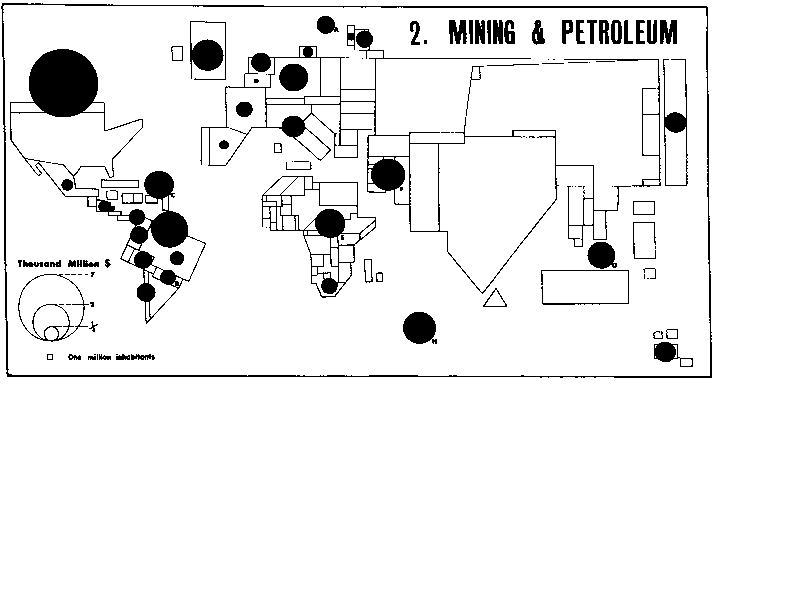 | Caption: Fig 2: Investments in Mining and Petroleum.
These represent over one-third of the US total foreign investment; over two-fifths is in the countries of the White North. Key to letters as in Figure 1. |
 | Caption: Fig 3: Investments in Manufacturing.
Over four-fifths of these are in the developed nations of the North. Key to letters as in Figure 1. |
 | Caption: Fig 4: Total Earnings of US Foreign Investments.
Almost one-half of the total earnings come from the "less-developed" nations. Key to letters as in Figure 1. |
In 1930 the foreign investments of the USA represented slightly over one-third of the total for the leading capital-exporting countries; by 1960 this proportion had risen to three-fifths. This very great expansion means, as Harry Magdoff points out, that "the United States is able to compete in foreign markets directly rather than by exports alone".47 Such investments make possible a double-penetration of foreign markets by US capital, for they obtain a share of the market of the country in which the affiliate is located and they enter into the foreign trade of countries competing with the USA; for example, almost one-quarter of the output of US plants in Europe is exported. The total book value of direct US foreign investments was almost $71 billion at the end of 1969. Of this total, almost two-thirds was in the developed nations, with Canada and Europe each showing totals of some $21 billion and the developed nations of the Western Pacific (Japan, Australia, New Zealand) accounting for approximately $5 billion. 20 per cent of all investments were in Latin America and only 2.5 per cent in the Middle East but this 2.5 per cent generated 14 per cent of the total earnings of US direct overseas investment. Over one-third of all foreign investment is in the mining and petroleum sectors. Up to the 1920s the United States was a net exporter of minerals but by 1961 14 per cent of the minerals needed by US industry was imported; by 1966 43 per cent (by weight) of US iron ore needs was imported and the country was heavily dependent on imports for a large number of strategic minerals.48 And, looking to the future, an American technical journal estimates that by 1985 half of the country's oil needs will have to be met by imports.49 Almost one-quarter of US mining and petroleum investment abroad was in Canada, 22 per cent in Latin America and almost 20 per cent in Europe. Only $1.5 billion were invested in projects in the Western Pacific; given the offshore oil potential of this region, however, the Chase Manhattan Bank predicts that in the coming decade capital expenditures in the petroleum industry alone may reach $36 billion in the Asian/Pacific region.50 Slightly over two-fifths of US foreign investments are in manufacturing industry and by far the greater part of these investments ($24.3 billion dollars, out of $29.4 billion) is in the developed nations. Europe has attracted one-half, Canada one-third and Japan and Australia-New Zealand-South Africa one-tenth. The thrust of US expansion in the manufacturing sector is clearly indicated by the fact that "US ownership in foreign manufacturing affiliates increased $3.00 billion during 1969... The developed countries accounted for $2.6 billion of the 1969 increase." Investment in West German manufacturing affiliates increased during the year by nearly $0.5 billion, in other EEC countries by approximately the same amount, and in the UK by $0.3 billion.51 The total earnings of US foreign investments in 1969 were $7.95 billion and, as Figure 4 demonstrates, it is when we consider the volume of earnings, rather than volume of investments, that the importance of the Third World in the US economic empire becomes apparent. The so-called "less-developed countries" account for 28 per cent of total US investments overseas but account for almost one half of the total earnings - and of the total earnings derived from these countries almost two-thirds is accounted for by the petroleum industry. As comparison of Figures 1 and 4 drives home, the proportion of total overseas earnings accounted for by the nations of the White North is considerably below their share of US overseas investments. Thus, as Claude Julien has pointed out,52 this "pillage of the Third World" becomes an important element in what is, in simple terms, an updated version of the old Triangular Trade: very high profits on investments in the Third World {50} provide the funds which make possible an increasing economic colonisation of the rest of the White North and of areas which at present are less profitable such as parts of Africa and Oceania. Under these conditions, the whole system would be undermined if any sizeable sector of the Third World should attempt to escape from the Free World and begin to utilise its resources to improve the living levels of its own people. The Second Indochinese war and the pressures against the Chinese People's Republic were in part tutelary measures designed to demonstrate the retribution which such behaviour would bring.And should the tactless question be posed: Who benefits from the system? - it has to be admitted that in 1966 "sixteen firms ... receive over half of all profits returned to the US from foreign investments".53 Servicing the Machine ...
In this era of recurrent monetary crises the '"international banker" tends to displace the film star and the TV star in the newspapers of the White North -while at the same time being a good deal more modest and shy ... This modesty and shyness, however, does not completely conceal the reality that the '"international banker" is about as "international" as the IMF or the "World" Bank. As Martin Nicolaus reminds us: "Of course the major banks all operate internationally, and none of them can be accused of patriotism, but through their ties and interlocks with major corporate clients, the banks nevertheless retain a national base"54 (emphasis in original). The "national base" of the Chase Manhattan Bank or the Morgan Guaranty Bank is, in truth, scarcely more in doubt than their more explicitly named compatriot the Bank of America ... Early socialist analyses stressed the importance of banks and finance capital in the process of capitalist imperialism and the postwar expansion of the world activities of US banks bears out the accuracy of such analyses. In the last two decades the number of foreign branches of US banks has increased fivefold and their assets tenfold. For the period covered by Figures 5 and 6 the total has risen from 124 in 1960 to 460 in 1969 (and 532 in 1970).55 The thrust of expansion has been, first, towards the Caribbean and Latin America; secondly, towards the UK and the EEC. And as the 1969 map shows, the banking boys have followed hot on the heels of the military and the politicians in Asia - though whether the paper empire built by the bankers will prove more enduring than the empire of steel Westmoreland and his buddies strove to build has yet to be demonstrated...  | Caption: Figs 5 & 6: Expansion of US Banking System 1960-69.
The expansion in number of overseas branches of US banks illustrates the US financial penetration of both the developed societies and the Third World. | |
The role of the banks in making possible the penetration of Europe by US-capitalism has been commented on by Martin Nicolaus;56 their wider role in the consolidation of Empire has been summed up by Rick Wolff: "the largest US banks can influence the pace and the directions of economic development wherever they move. They exert such influence in the way they gather deposits, offer loans, affect local credit conditions and collect crucial intelligence on the local economy"57 Uncle Sam's Wayward Nephews
That Uncle Sam's economic control of his dependents may be weakening is suggested by Figures 7-9 which show the degree of economic dependency of various countries, as measured by the proportion of total imports supplied by the three major "Free World" metropolises in 1958 and in 1968. Figure 7 shows degree of polarization of trade on the USA and is the key diagram.  | Caption: Fig. 7: Polarization of Trade on the USA 1958-1968.
Countries are shown proportional in size to their population. |
Over the decade 1958-68 the majority of Latin American countries edged out of Uncle Sam's clutches and appear to be moving towards greater diversification of their import trade. Most of the countries of Europe seem to be moving away also, though less precipitately. But perhaps the most striking shifts appear in Asia; here many of America's most dependable allies show an apparent general weakening of their economic links with the USA, the outward shift being specially large in the cases of South Korea and the Philippines. By contrast, several countries - e.g. Indonesia, India, Malaysia - have been drawn into a closer relationship. All the major African countries (with the significant exception of Libya and the UAR) have also edged into a closer relationship with the US, reflecting in part the doubling of US investment in Africa over the last decade and the growing US interest in Africa's strategic materials.58 And it is notable that the UK and all the White Dominions - New Zealand, Australia and Canada - have increased in importance as markets for US exports. Figure 8 uses the same measures and techniques as Figure 7 and might appropriately be subtitled "The Sorcerer's Apprentice".  | Caption: Fig 8: Polarization of Trade on Japan 1958-1968.
Using same techniques as Figure 7. Japan, it would appear, is competing strongly with the USA in Southeast Asia and East Asia and by 1968 was beginning to establish a foothold in Africa, the Middle East and Latin America. |
Japan, whose economic consolidation was encouraged by the USA so that the country could act as a counterpoise to the Chinese People's Republic, has, it can be seen, now acquired a dynamism of its own. The rapid economic development of recent years has led the country into increasingly effective competition with the USA and this seems to be showing itself in the gravitational pull of the Japanese economy on a number of Asian/ Pacific countries. Comparison with Figure 7 suggests that many of the countries shifting out of the US orbit are being drawn into the Japanese orbit; outstanding examples are South Korea and the Philippines. Other countries such as South Vietnam, Thailand and Indonesia are exposed to the pull of both the USA and Japan, though the shift towards Japan is usually the dominant shift. More recent data would undoubtedly show an acceleration towards {53} the Japanese centre; thus in 1970 40 percent of the Filipino trade was with Japan. The New Shape of Empire
Let us attempt to put these phenomena into context.Very early in the so-called decolonisation process it became evident that what the former colonies were achieving was "independence from a single imperialist power and not independence from the imperialist system as a whole".59 The same observation can be applied to nations which appear to be showing a growing tendency to attempt to escape from the economic domination of the USA; unless they break completely with the system, as the East Asian socialist nations have done, they are merely exchanging one master for another. Indeed, given the large-scale penetration of many of the developed economies by American capital, what may appear as a trading shift away from the US metropolis may in reality be merely a shift from trade with a US-based corporation to trade with an affiliate of the identical corporation, located geographically in some overseas country but closely tied in to the US economy. In the words of Martin Nicolaus: "at least some of the 'competition' now faced by US industry originates not with 'foreign' capital, but with the imperial branches of US corporations themselves... Since there is no first-glance way of telling which 'foreign import' is actually a US-imperial 're-import', caution should be exercised in drawing political-economic conclusions from 'made in Japan' or 'made in Germany' labels."60
 | Caption: Polarization of Trade on the EEC: Asia only.
Suggesting a weakening commercial influence of the EEC in the Indian subcontinent and parts of Southeast and East Asia and trend towards displacement of US by EEC and Japan in the case of countries such as the Philippines. Data for China not strictly comparable as socialist bloc is excluded. |
And the extent of this US penetration and subversion of national economies all over the Free World is to be seen from the fact that, according to Leo Model: "on the basis of the gross value of their output, US enterprises abroad in the aggregate comprise the third largest country (if such a term can be used to designate these companies) in the world - with a gross product greater than that of any country except the United States and the Soviet Union"61 One out of every nine workers in Scotland is employed in a US-owned enterprise62; over half of Britain's cars and over two-fifths of Britain's output of computers and refined petroleum products in the mid-sixties came from US-owned companies, as did over one-third of France's tractor and agricultural machinery output and over one-quarter of her output of washing machines...63 It's against this background that we should see the term 'third Europe', a term devised by European capitalist groups 'to signify that sector of the European economy which is neither socialist nor European capitalist, but under US-capital control'.64 With the accelerating growth of the multinational corporation a new world situation is emerging, for the close convergence of interests between these multi-national colossi is leading to a growing integration of the White North, an integration which is beginning to transcend ideological frontiers.65 Says Philippe Beaulieu: "the 29 rich countries are moving towards the creation of a zone of 'high development' based on the components of modern civilisation: the mastery of an advanced technology, large-scale and complex trade and the availability of abundant financial resources. The links between this 'group of super-rich' and the poor countries on the periphery are tending to become limited to, on one hand, the supply of indispensable raw materials (cotton, petrol, some metals and minerals) and, on the other hand, the supply of some contingents of labour since the dwellers in the developed countries are already refusing to themselves undertake certain types of manual labour"66 The exploitative pressures on the Third World are thus likely to become increasingly uneven in their impact, with some sectors of the Third World economies tied ever more tightly into the super-economy of the White North and great areas continuing to stagnate. And all the time the economic gap between that small, largely white, sector of mankind belonging to the club of the super-rich and the great majority of humankind, who are dominantly coloured, will inexorably widen.And, given that the great majority of multinational corporations are American-dominated and that "the main instrument of the multinational corporations in the world today"67 is the US government, the drive to obtain that global freedom of action which the great corporations need will involve the United States in a continuing policing of the marches of Empire to deter other nations from following the example of the Chinese or the Vietnamese and making a leap into freedom. Indeed, since the policies of the American-dominated multi-national corporation are incompatible not only with the human needs of most mankind but also with many of the perceived national interests of many of the developed nation-states of the White North the US government may find itself drawn, through its involvement with these corporations, into a pattern of protracted pressures and economic conflicts with these nation-states.
 | Caption: The New Globe-spanning Economic Empires.
The distribution of the subsidiaries of Standard Oil, New Jersey, as of 1962 illustrates the global pattern of the giant corporation which is tending to displace the old nation-state as the unit of economic organisation. |
Of one thing we may be certain and that is if America "can't achieve a world of states on the US pattern, at least it is determined to do its damnedest to achieve a world of obedient satellites".68
FOOTNOTES
1. NACLA Newsletter November 1970, "The Mercenarization of the Third World" by Michael Klare, pp. 11-19; NACLA Newsletter, March 1970, "Chemical Warfare Training in the US for Foreign Military Personnel" (from Congressional Record), pp. 11-14; Africa Research Group, International Dependency in the 1970s, esp. pp. 54-56. See also Claude Julien, L'empire americain (Paris, 1968).
2. Richard Barnet, Intervention and Revolution: The United States in the Third World (London, 1970), pp. 12-20.
3. Given the exclusion from the programme of such populous countries as India the ratio is probably closer to one policeman to 1,250 people. And given that much of the unrest is urban unrest and that probably less than one-fifth of the Third World's population can be regarded as urban the effective ratio may well be nearer 1:250.
4. Wayne O'Neil, "Who Says Thailand's Next?" in New Republic, 9 Jan. 1971, p. 35.
5. See Keith Buchanan, "The Nature of Reality: Some Guide-books for a Guerrilla World" in Journal of Contemporary Asia, Volume 1, Number 2, Winter 1970.
6. The Sermons of John Donne, ed. Theodore Gill (New York, 1958), p. 93.
7. See J.-P. Sartre's preface to Franz Fanon, The Wretched of the Earth, (Harmondsworth, 1967).
8. Africa Research Group, How Harvard Rules (Cambridge and Boston), pp. 1-2
9. Claude Julien, L'empire americain (Paris, 1968), p. 292.
10. "American Business Abroad" in Saturday Review, 22 November 1969, pp. 31-46
11. Congressional Record - Senate, 1 May 1969, S4417 sqq.
12. Pierre Jalée, Le tiers monde dans l'economie mondiale (Paris, 1968), p. 112.
13. Claude Julien, op. cit., p. 286
14. ibid., p. 283.
15. Claude Julien, op. cit., p. 283, quoting L'exode des cerveaux (Lausanne 1968).
16. cited in Kontinente: das Neue Missionsmagazin (Oberhausen), January 1968, pp. 3 and 25.
17. ibid., p. 3.
18. Raymond Williams, ed., May Day Manifesto 1968 (Harmondsworth 1968), pp. 65-66.
19. cited by Noam Chomsky, American Power and the New Mandarins (Harmondsworth, 1969), p. 260.
20. Preface to Pauline Rèage, The Story of O (New York, 1965), pp. xxi-xxii.
21. Claude Julien, op. cit., p. 341.
22. ibid., pp. 293-294
23. Philip G. Altbach, "Neocolonialism and Education" in United Asia, May-June 1970.
24. Africa Research Group, Africa Report (Cambridge and Boston, 1970).
25. ibid., p. 60
26. ibid., p. 76.
27. T.V.L. Blair, Africa: A Market Profile cited in Africa Report, p. 77.
28. Behavioral Sciences and the National Security, Report No.4 (House of Representatives, 6 December 1965, p. 33).
29. For an alternative vision see Grant Kamenju, "In Defence of a Socialist Concept of Universities" in Transition, No. 35, pp. 15-17.
30. Congressional Record - Senate, 1 May 1969, p. S4417.
31. ibid. These statistics do not include the funding of 20 major "classified" projects.
32. Neil J. Smelser, Social Change in the Industrial Revolution (London, 1959), p. 58.
33. on this see Noam Chomsky, op. cit., and How Harvard Rules.
34. Africa Research Group, International Dependency in the 1970s (Cambridge, Mass., 1970), p. 41.
35. On Israel's role in world affairs see Africa Research Group, David and Goliath Collaborate in Africa (Cambridge, Mass., 1969) and for an earlier and briefer comment Keith Buchanan, "'Zionism, the Arabs and the Third World", New Zealand Monthly Review, August 1967, pp. 5-6.
36. Seymour Hersh, "Germ Warfare" in Ramparts, December 1969, p. 26.
37. Michael Klare, "The Great South Asian War" in Nation, 9 March 1970,
38. "Feather Merchants" in Nation, 8 June 1970, p. 677.
39. Claude Julien, op. sup. cit., p. 301.
40. Claude Julien, L'empire americain (Paris, 1968), p. 29.
41. from Economist Diary 1971, p. 61.
42. for this concept see Pierre Pradervand, "Les pays nantis et la limitation des naissances dans le Tiers Monde" in Developpement et Civilisations, March-June 1970.
43. Lauchlin Currie, "Economics and Population" in Population Bulletin, April 1967, p. 31.
44. cited by Pierre Pradervand, op. cit., p. 25.
45. Peter Townsend, The Concept of Poverty, London, 1970, p. 2.
46. Paul A. Baran and Paul M. Sweezy, "Notes on the Theory of Imperialism" reprinted in K. T. Fann and Donald C. Hodges (ed.), Readings in US Imperialism (Boston, Mass., 1971, p. 77.
47. Harry Magdoff, "The Age of Imperialism" in Monthly Review (New York), June 1968, p. 40.
48. Harry Magdoff, op. cit., p. 30.
49. Oil and Gas Journal, 25 January 1971.
50. Business and Financial Trends (Chase Manhattan Bank) March 1970, p. 28.
51. Survey of Current Business, Oct. 1970. pp. 28-29.
52. Claude Julien, op cit., pp. 229-300.
53. Africa Research Group, International Dependency in the 1970s (Cambridge, Mass., 1970), p. 30.
54. Martin Nicolaus, "Who Will Bring the Mother Down?" in K. T. Fann and Donald C. Hodges, op cit., pp. 281-282.
55. Annual Reports of the Board of Governors, Federal Reserve System.
56. Martin Nicolaus, op. sup. cit.
57. Rick Wolff, "The Foreign Expansion of US Banks" in Monthly Review, May 1971, p. 29.
58. Harry Magdoff, "The Age of Imperialism: Part Three" in Monthly Review November 1968, pp. 32,37.
59. International Information Centre, World Bank Report (Copenhagen 1970), p: 5.
60. Martin Nicolaus, op. cit., p. 284.
61. Leo Model, "The Politics of Private Foreign Investment" in Foreign Affairs, June 1967, p. 641.
62. cited by K. W. Wedderburn in New York Review of Books, 18 June 1970, p. 23.
63. Harry Magdoff, in Monthly Review, June 1968, p. 45.
64. Martin Nicolaus, op. cit., p. 283.
65. Philippe Beaulieu, "Pays riches, pays pauvres" in Projet (Paris), July-August 1970, esp. pp. 789-795. Beaulieu gives examples of the export of Western technological expertise to the Soviet bloc and of the financial ties developing between Western and Eastern Europe.
66. ibid., p. 792.
67. Harry Magdoff and Paul M. Sweezy, "Notes on the Multinational Corporation" in K. T. Fann and Donald C. Hodges, op. cit., p. 113.
68. ibid., pp. 113-114.
Back to top of page Top
big-lies site Main Index
Comments? Click to Email
|